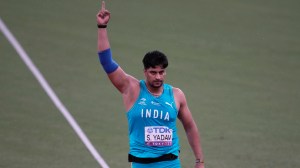Tirkey’s journey from chicken cup to champion
One evening 10-odd years ago, a group of boys were playing hockey on a dusty, grassless, pot-holed ground in an Orissa village. Unkempt, bar...

One evening 10-odd years ago, a group of boys were playing hockey on a dusty, grassless, pot-holed ground in an Orissa village. Unkempt, bare-footed, some even bare-bodied, they were oblivious to their surroundings; all that mattered was the ball that they were striking with a bent bamboo stick.
It was a high-stakes final, with two villages turning out en masse to see which team would take home the prize. Eventually, Saunamera village went home with the ‘Kukuda (chicken) Cup’, a large dressed chicken. The hero of the winning team was a young lad with scrawny legs and a wiry frame; the star of the evening, he could wield his bamboo stick like Sachin Tendulkar handles his cricket bat. That was Dilip Tirkey.
Today Tirkey (aka ‘The Wall’) is a national hero; he’s no less a hero in Saunamera, though he doesn’t play there any more. ‘‘One day, a couple of men came here from the city and watched a match in our village. When it was over, they spoke to Dilip’s parents and took him away.’’ That was the last time the villagers saw him bare-foot on a hockey field.
If that’s the story of Dilip Tirkey, it could also be the story of Ignace Tirkey, his brother Prabodh and Lazarus Barla. One can even add the names of William Xalxo and Bikas Topo (both junior India internationals). Or of Jyoti Sunita Kulu, Teresa Kujur, Sabita Ekka. All products of the tribal-dominated western Orissa district of Sundargarh.
Elsewhere in India, the national game may have lost out to cricket but in this hilly area, it’s alive and kicking. Electricity has still to reach Barla’s village Tekeikani, while Saunamera was hooked up only recently. But it’s hockey that keeps them going.
For the people there, hockey isn’t merely a game, it’s a way of life, an intrinsic part of their culture. Like the stick is almost part of their attire, carried almost everywhere they go. There’s a ‘Kukuda Cup’ match every day; if not, they’re playing for the ‘Khasi (goat) Cup’.
Says Silvester Topo, coach at the Panposh Sports Hostel in Rourkela, the district’s biggest city: ‘‘For the tribals here, the hockey stick is a part of their body and the game part of lifestyle. You may imagine Mumbai without cricket but there cannot be a day without hockey in Sundargarh.’’
The hostel was started by the state government in 1985 as a way of tapping the raw energy and talent of the youth. Topo, who had represented the State at the Nationals, was instrumental in its running, and in building the careers of those whom he coached.
Soon, the Rourkela Steel Plant and Sports Authority of India followed suit in bringing up their own centres. A way of life then became a way of livelihood and this region turned into a breeding ground for regular, fulltime hockey players. Today, the Orissa women’s hockey team is drawn entirely from this district. Despite the success, though, there is a lot to be done in terms of facilities here.
The astro-turf at the Sports Hostel in Rourkela looks like the Saunamera ground where Dilip played with bamboo sticks. Repeated pleas for repair work have fallen on deaf ears of the the State government. The Sail Academy, run by the RSP, has no astro-turf. The game is taught on grass at the SAI hostel in Sundargarh.
But there’s always the promise of hope. Says Olympian Michael Kindo, acknowledged as India’s greatest tribal hockey player: ‘‘The success of Dilip Tirkey and Lazrus Barla has inspired a whole generation. Although poverty-stricken, they want to play hockey. Parents too have started encouraging their children to take up the game. With academies and sports hostels around, hockey has become the route to success and jobs. For some, stardom too.’’
Photos



- 01
- 02
- 03
- 04
- 05




























